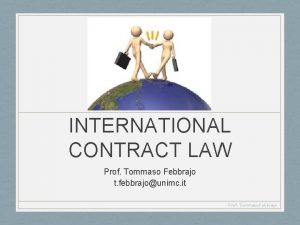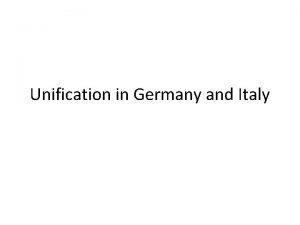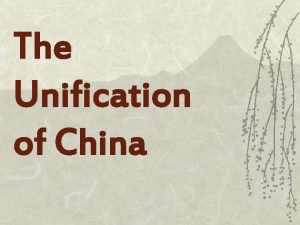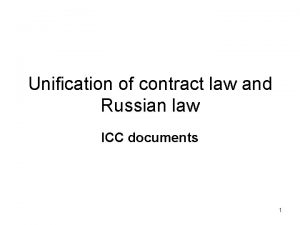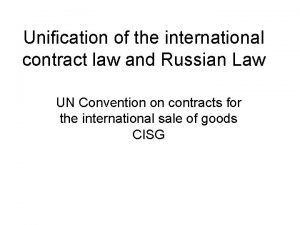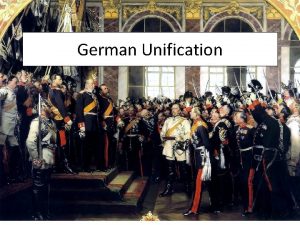Unification of International Contract Law and Russian Contract





















- Slides: 21

Unification of International Contract Law and Russian Contract Law Nina Vilkova Dr. sciences juridical Professor, Russian Academy of Foreign Trade, Moscow Arbitrator, ICAC, Russian Federation CCI 1

Unification Terminology: unification, approximation, standartisation, coordination, harmonisation Unification: a process of elaborating and adopting of uniform for different states rules aiming to regulate commercial relations and to create uniform legal environment 2

Main factors leading to Unification of contract law Political and economical factors: • Economic development of different countries • Internationalisation and globalisation of economy, transnational movement of goods and services, growth of transnational contacts and contracts • Development of direct cooperation between private actors of commercial relations, diversification of economic contracts • Contradiction between international character of economic relations and their national legislation 3

Main factors leading to Unification of contract law Legal factors: • Different legal systems in the World – common law and civil law, • legal systems in the new independent states, recent example: Baltic and CIS countries • Impossibility of adequate regulation of transnational commercial relations by national legislation • Unification of private international rules (in Russian - Conflict of Law rules) versus unification of substantive rules 4

Unification of contract law Significance: development of uniform rules for transnational economy in the fields: universal and regional unification, unification of PIL rules and substantive rules, elaborating of new instruments and by new privates players Universalism-regionalism of unification of contract law 5

Foreign and Russian academicians • R. David, C. Schmitthoff, E. Rabel, J. Basedow, I. Bonnel, A. Farnthworth, J. Honnold • • Lunz L. A. – Private International Law in 3 volumes, Boguslavskii M. M. – Private International Law, 5 th edition Zvekov V. P. – Private International Law, 2 th edition, Authors of the Commentaries of the 3 rd part of Russian Civil Code: T. Abova, M. Bardina, I. Zykin, E. Kabatova, A. Komarov, A. Makovskii, N. Marisheva, O. Sadikov, M. Rosenberg, N. Vilkova 6

History of the unification • R. David – 2 periods: 1. national codification, elimination of “different legal dialects” 2. Canonic law, academic transnational law • C. Schmitthoff – 3 periods: 1. development of transnational law merchant (the absence of national states and national legislation)- self-regulating process 2. creation and development of national states and of national jurisdictions – different legal systems 3. unification of law of international trade by adopting of international conventions , creation of international organisations (1893 - Hague conference on PIL, 1929 - International Institute for the unification of private law, 1966 - UNCITRAL XX – beginning of XXI century - the forth period begins – activity of formulating agencies, self-regulation of contract relations by actors of international trade 7

History of Unification Europe: • 1851 Pascuale Mancini, Italian minister of foreign relations – in Turin University gave a lecture “Prolusione”- on the Civil law as a ground for the law of nations”, • 1873 Insitute of international law in Genoa decided to elaborate draft of convention on PIL, • 1874 – Mancini prepared a report “On uniform rules of PIL for avoiding conflicts of civil and criminal law of different states” • 1883 – Mancini proposed to organise international congress with participation of 15 European states, USA and 14 states of Latin America • 1880 Tobias Acer (Netherlands) published an article “PIL and uniform law” and proposed to the government to held a conference- the first Hague conference on PIL was held in 1893. The Hague conference adopted more than 30 international conventions, including 2 conventions on the law applicable to international sale of goods, 1 – on the law applicable to agency agreements and 1 – on the law applicable to the transfer of title in the international sale of goods (only 1955 convention is in force now) 8

History of Unification Latin America states: 1878 – Treaty of Lima – contained a comprehensive codification of international law in the field of private law civil procedure and criminal law (60 articles) 1889 – Congress of Montevideo approved eight conventions dealing with PIL, law of civil procedure, copyright, patent and trademark law (on the basis of Paris Convention 1883 on protection of industrial property and 1886 Berne copyright Convention 1928 – Bustamante Code – in force in 15 states (author Antonio Sanches de Bustamante and Sirven) Americas: 1948 - Organisation of American States (1994 Mexico convention on law applicable to international contracts, 1975 – Inter-americain convention on international commercial arbitration) African states: 1993 – Organisation for the harmonisation of business law in Africa (OHADA) CIS: 1993, 1996 - Inter-parlamentary assembly approved Model Civil Code for CIS countries, on the basis of which all CIS countries adopted Civil Codes, Ukraine – Civil and Economic Code (in force from 1 January 2004) 9

Unification agencies • Universal governmental international organizations – the Hague conference on PIL, UN Economic commission for Europe, UNCITRAL, UNIDROIT, • Universal nongovernmental international organizations – International Chamber of Commerce, International Federation of Engineers - Consultants (FIDIC) • Regional governmental international organizations (Organisation of American States, CIS, OHADA) 10

CIS countries • regional unification: multilateral and bilateral -1992 Convention on resoling economic disputes, 1993 Convention on • approximation of law, as well modernization of substantive law and private international law - on the basis of model laws (Model civil code and others) 11

UNCITRAL • • • Main goals: national or regional harmonisation promotes national or regional trade and facilitates international harmonisation, helps to reduce the number of legal systems and provides a basis for international harmonisation. To avoid duplication of efforts and conflicts between the uniform and harmonised texts Working methods (Spiros V. Bazinas, senior legal officer, office of Legal Affairs, United Nations): Catholic participation – beyond UNCITRAL members, all member States of the United Nations and international governmental of non-governmental organisations with an interest in the UNCITRAL’s work are invited to participate in the UNCITRAL’s work as “observers”, they can participate fully both in the discussions and in the decision making, Orthodox consensus means that at the end. All participants must agree on a given result acceptable to all. The preamble of CISG contains a summary of UNCITRAL philosophy – it refers to the need to promote the balanced development of international trade on the basis of equality and mutual benefit. UNCITRAL products: international conventions, model laws, legislative guides 12

UNCITRAL • Examination of the relationship between international and regional harmonisation reflects the practice and working methods • Identify the real problem and to suggest effective solutions • UNCITRAL mandates – to further progressive harmonisation and unification of the law governing international trade (General Assembly resolution 2205 of 17 December 1966) • Most significant achievements: 1985 UNCITRAL Model Law on international commercial arbitration 1985 and 1980 UN Convention on Contracts for the International Sale of Goods (67 participants), UNCITRAL Model Law on Electronic signature, • Endorsement of ICC documents – Incoterms 2000, Uniform Customs for Payment by letter of credit 13

Hague conference on PIL – 1893 Mains achievements: 33 international conventions, 1955 Hague convention on the Law applicable to international sales, 1986 Hague convention on the Law applicable to international sales (not in force) the last one – 2005 Hague convention on jurisdiction and recognition and enforcement of foreign Judgments 14

UNIDROIT – 1929 • 1988 Convention on International financial leasing • 1988 Convention on International factoring • 1995 – Convention on the return of stolen or illegally exported cultural objects • 2004 Principles of International commercial contracts (1 st redaction – 1994) History: • 1930 – first draft of Sale of Goods convention (E. Rabel), • drafting of the 1984 Hague convention on “Uniform law on formation of contract” and on “Uniform Law of international sale of goods” • drafting of 1980 SIGS 15

International Chamber of Commerce – 1919 Main achievements: • Incoterms 2000 (first – Incoterms 1936) • Uniform rules and customs for letters of credit, for collection of payment, stand-by letters of credit • Model contract: of international sale of goods, of distributorship agreement, of agency agreement 16

Methods of unification Unification of conflict of law rules • 1955 and 1986 Hague conventions on law applicable to international sale of goods, 1980 Rome convention on law applicable to contractual obligations • History: Council for mutual economic aid – General conditions of delivery of goods – regional multilateral unification (1958 -1989) – both substantive and conflict of rules regional unification 17

Methods of Unification of substantive rules 1980 UN Convention on international sale of goods (Vienna convention, SISG) 1988 – UN Convention on International financial leasing 1988 – UN Convention on International factoring 2005 – UN Convention on electronic communication in commercial contracts 18

Methods of Unification International unification Elaborating and adopting by international governmental organisations of international conventions and recommendation (model laws, guidelines, etc. ) Private unification Elaborating by governmental and nongovernmental organisations of soft law – non binding rules adressed to private actors 19

Realisation of international documents Ratification of international convention 1980 CISG – 1988 – entry into force, 1980 Rome convention – 1988 entry into force Adopting of national law on the basis of UNCITRAL model laws (1985 Model law on International commercial arbitration - more than 40 countries adopted their national laws) Incorporation, Transplantation of international convention into national law – some article of CISG are incorporated in the Model of Civil Code for CIS countries, in Civil Code of Argentina, some Principles UNIDROIT – in chinese legislation 20

Methods of unification used by CIS countries • Ratification of international conventions: CISG - 11 postsoviet countries, 1958 New-York convention on recognitions and enforcement of foreign arbitral awards – 13 postsoviet countries • Adopting of national law on the basis of UNCITRAL Model Law (Russian 1993 Law on international commercial arbitration, Russian Law on Electronic signature, etc) • Incorporation of provisions on international conventions into Model CIS Civil code and into national Civil code of CIS countries • Implementation of UNIDROIT Principles of international commercial contracts: as a guidelines for drafting contracts, then elaborating new legislation, and resolving disputes our of international contracts 21
 International contract law
International contract law Newton's first law and second law and third law
Newton's first law and second law and third law Newton's first law of motion
Newton's first law of motion German and italian unification compare and contrast
German and italian unification compare and contrast Chapter 23 lesson 3 nationalism unification and reform
Chapter 23 lesson 3 nationalism unification and reform National unification and the national state
National unification and the national state Ifrs 15
Ifrs 15 Contingent contract and wagering contract
Contingent contract and wagering contract Boyle's law charles law avogadro's law
Boyle's law charles law avogadro's law Constant in avogadro's law
Constant in avogadro's law Unification prolog
Unification prolog Italian unification summary
Italian unification summary What was the most serious obstacle to german unification?
What was the most serious obstacle to german unification? Zollverein germany map
Zollverein germany map Germany before unification
Germany before unification St an
St an Unification operating model
Unification operating model Unification first order logic
Unification first order logic Germany before unification
Germany before unification Why was italian unification difficult to achieve
Why was italian unification difficult to achieve Unification of china
Unification of china Prolog unification
Prolog unification
